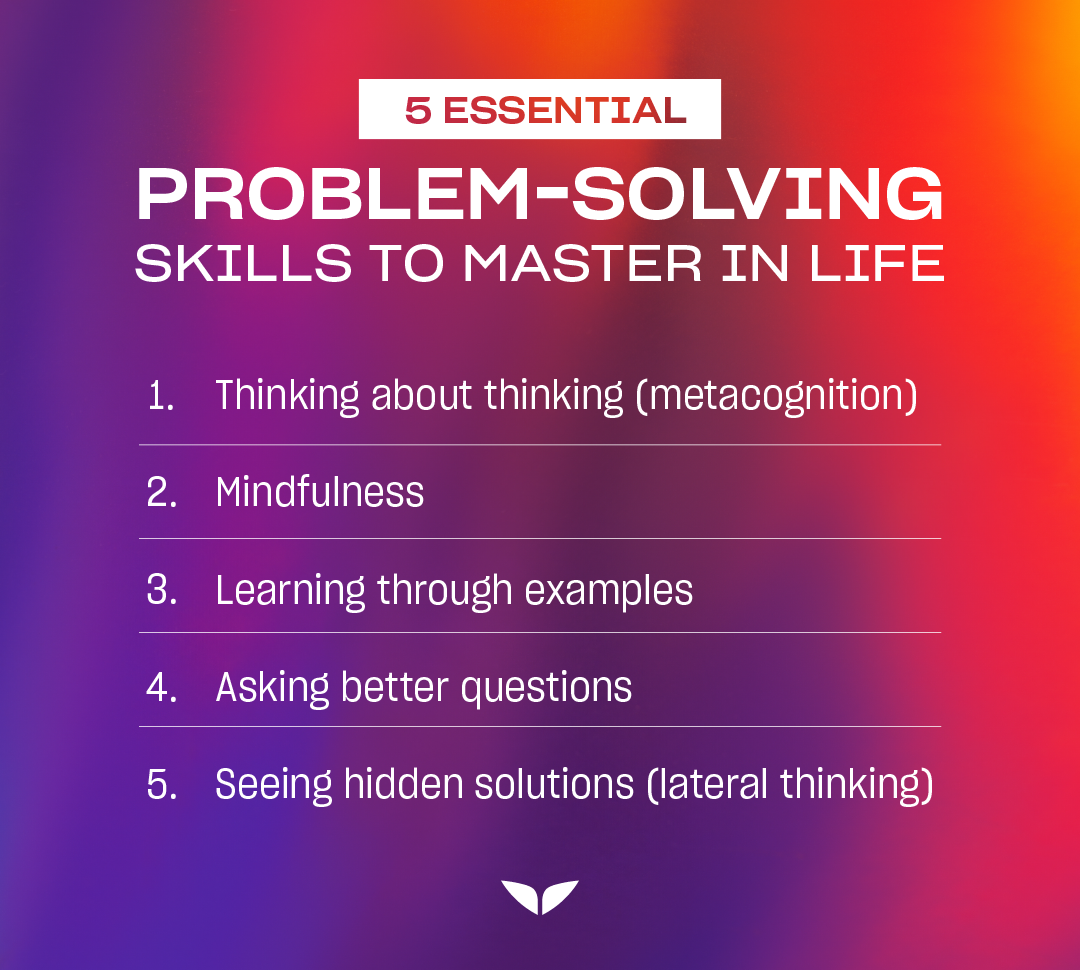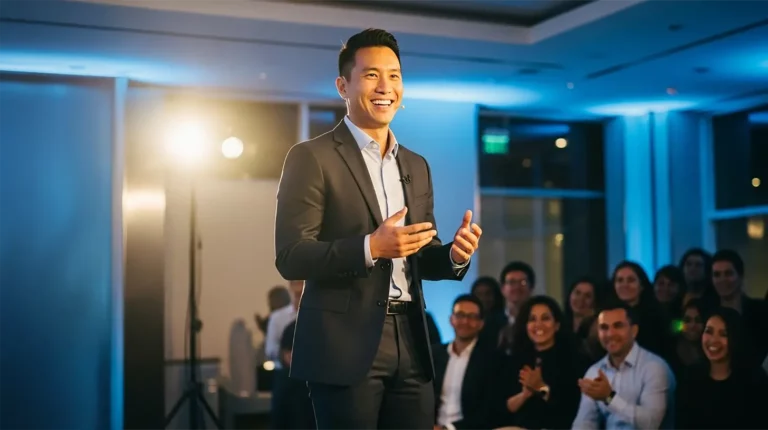There’s a chance that something’s been weighing on you lately.
Maybe it’s a career move you can’t seem to map out. Or you’re stuck on a creative project, halfway between vision and execution. Perhaps it’s a fractured personal relationship that’s keeping you up at night.
Whatever the situation, you’ve likely thought it through. Heck, maybe even exhausted all what-if scenarios, possible to-do lists, and self-help books. And still, nothing’s changed.
Have you ever considered that the real shift you need is likely in learning how to improve your problem-solving skills? That instead of solving harder and pushing that “boulder” of problems uphill, it’s about thinking differently altogether?
Yep, no Sisyphean battle here. Just a new route towards a new direction.
If that hits you in the feels, it’s probably time to move from problem mode to solution mindset. Thankfully, the latter’s a skill that can be trained, like every other.
Why problem-solving matters
Simply put, life will always throw you lemons. Thankfully, nature built your brain to shift into problem-solving mode the moment things go sideways. Like when a delayed email costs you a deadline, or a conversation takes an unexpectedly sharp left turn.
And you don’t always need cold, hard logic to do it. According to Harvard psychologist Howard Gardner, different types of intelligence work behind the scenes to help you nip it in the bud. Each one lets you approach problems in a way that fits how you’re wired.
If you have linguistic intelligence, for example, you’d tend to lean into storytelling to get your points across. With kinesthetic intelligence, your body does the solving before your brain catches up, like when you dance, train, build, or move. And if you’re wired for intrapersonal intelligence, you solve through human patterns and subtle shifts in expression.
Luigi Sciambarella, a clinical hypnotherapist, board member of The Monroe Institute, and the trainer of The Unbound Self program on Mindvalley, calls it the meeting of the left-brain logic with right-brain intuition. As he says, “Solving problems is not a linear left hemisphere activity. It’s a whole-brained process we do more effectively when we reach an open, receptive state.”
So, it’s never just about how much you know, but rather, how fast and well you can pivot in the face of challenges. This comes down to critical thinking, according to renowned hypnotist and behavioral scientist Paul McKenna. That’s simply your ability to pause, zoom out, and see the whole picture before making decisions.
“The more ways of looking at something you have, the more choices you have,” he says in his Mindvalley program, Everyday Bliss. “The more choices you have, the more likely you’ll end up in control.”
And the good news is that this flexibility is trainable, just like fitness. All you need is the right framework to see the glass half full.
Clarifying our purpose is the first step to effectively gauging how urgent or important solving this problem is.
— Luigi Sciambarella, hypnotherapist at The Monroe Institute and trainer of The Unbound Self program on Mindvalley
4 examples of problem-solving skills
While most people assume problem-solving lives in logic alone, the truth is, it’s also about emotional pacing, intuition, and timing.
Ever wondered how to improve critical thinking and problem-solving skills without burning out or spiraling? Well, the key is in training both your hard skills and soft skills. The former helps you break down problems, map solutions, and follow through. And with the latter involved, you lessen the risk of hitting a wall when stress takes over.
Below are five examples of skills where both modes meet:
1. The Polya method
This one gives your brain a backbone when things feel formless, thanks to mathematician George Pólya. He broke down the solution to every problem into four essential actions:
- Understand what’s at hand,
- Devise a plan,
- Execute it, and then
- Reflect on what worked and what didn’t.
Sounds basic, sure, but it works. A 2024 study found that students trained in Polya’s framework consistently outperformed their peers in complex tasks. Gender, age, and background didn’t matter. The structure itself created the clarity.
Luigi echoes the importance of knowing what you’re solving. According to him, it sets the tone for everything in your problem-solving approach. “Clarifying our purpose,” he says, “is the first step to effectively gauging how urgent or important solving this problem is.”
2. Cognitive flexibility
You try something new, and it flops. Maybe you’d freeze or spiral on the spot. Or maybe, if you’ve built the muscle, your mind just shifts gears and tries again.
The difference between the two is cognitive flexibility, the ability to change your mental lane when something doesn’t make sense. In this zone, you stop needing the perfect answer and move with what’s unfolding in front of you.
It’s also one of the most valuable skills you can train. A study found that people with higher cognitive flexibility made stronger decisions in fast-moving settings like hospitals and classrooms. And not because they’re equipped with knowledge, but because of the fact that they can think on their feet.
Just when you think it’s about knowing a lot, it’s about having enough mental room to move in. With that comes certainty about what you’re doing.
“Once you’ve got the state, then the strategy becomes obvious,” says Paul. “But if you don’t have the right state, the strategy is almost impossible to see.”
3. Adaptive traction
Sketching freehand, managing your household mid-Zoom calls, scanning the market for trading positions… In moments like these, you move on instinct, memory, and insight, as you figure things out on the go—in a process called adaptive traction.
Studies show that doctors, teachers, and astronauts rely on this kind of thinking even without a rulebook in emergencies. They know their stuff, sure, but more importantly, they know how to read the moment. Their ability to pivot well helps them catch mistakes before they snowball and stay calm even in the thick of uncertainties.
This kind of thinking deserves airtime, whether in classrooms, leadership training, or simply day-to-day conversations. As Luigi explains, “We gain a broader perspective on the problem and even on the solution and the options we can choose.”
4. Reframing
Sometimes, what’s in your way is how you look at a problem, not the problem itself. Reframing it helps, because when you step outside of your vantage point, you can see that:
- Delay is actually an extended room to breathe.
- Rejection is, in fact, redirection.
- A setback is data about your process, not a defeat.
The opposite of reframing? Functional fixedness, or when your brain is stuck on only one use, meaning, or story. Meanwhile, unlearning something, even slightly, can open room to new possibilities.
And here’s the kicker: people who practice reframing are found to be better at creative problem-solving and long-term decision-making. Ergo, they prefer to make space for possibility instead of jumping to conclusions.
Paul, for one, calls this a necessary skill for clarity. In his words, “If you can relax and ask a better question—like, ‘What do I need to do differently?’—then you start to get better answers.”
5 best ways to improve problem-solving skills
Problem-solving is like a muscle. You build it the same way you build strength… through reps, rhythm, and knowing what to train. No magic needed, only skill-stacking done right.
Here are five moves that stretch your mind in the right places:
1. Metacognition (thinking about thinking)
Metacognition is the ability to step outside your thoughts and watch how your mind moves. It’s how you can see your tendency to overthink, ruminate, rush things, or glaze over.
The benefits of doing this are great. Students who practice metacognition were found to outperform their peers in creative and analytical problem-solving tasks by leaps and bounds.
So it’s clear: once you’re aware of the patterns that reign free in your mind, you get to work on them. A good way to do this is to run a “thinking debrief” after encountering a challenging situation. Write what went down, how you responded, and where you got stuck.
Then ask yourself:
- “What assumption did I make too quickly?”
- “What could I try differently next time?”
Even a two-minute reflection sharpens your decision-making over time.
2. Mindfulness practices
Remember Luigi’s whole-brain state concept? It’s how ideas and insights come to light. “When the mind gets quiet,” he points out, “we can see the full shape of the problem and move with more confidence.”
No wonder it’s encouraged at The Monroe Institute through sound healing and mind-body healing approaches.
And there’s proof in the pudding. The science of mindfulness has shown increased synchrony between the brain’s left and right hemispheres during meditation sessions, particularly in areas associated with insight and attention.
Of course, you don’t have to fly to the institute to start zenning out and cracking the puzzles of life better. A few grounded shifts in your daily life can activate the zen:
- Pick up meditation; start with five minutes every morning.
- Try the 4-4-8 breathing for three minutes before making a hard decision.
- Use ambient binaural beats during deep focus work.
- Name your feelings whenever you feel yourself mentally looping.
- Go phoneless while taking a walk.
In the zone, your mind gets laser-focused, and you’ll begin to see solutions ahead of you.
3. Worked examples
Sometimes the brain needs to see a problem solved first before it can do it well. That’s the premise of the “worked example effect.” It’s used in elite math classrooms, medical training, and even chess coaching.
Students who studied modeled steps are shown to learn faster and retain more than those thrown into problem-solving without a reference.
So, the next time you’re learning a complex skill or tackling an unfamiliar challenge? Don’t start from scratch. Do these instead:
- Find one good example.
- Break down the logic and trace the moves.
- Then try it yourself and see how you handle it.
A strong reference point doesn’t hold you back; it gets your brain to perceive solutions faster than guesswork ever could.
4. Asking the right questions
Problem-solving often hinges on the quality of your questions. It’s easy to fall into loops like “What’s wrong with me?” or “Why does this always happen?” But those questions don’t lead to solutions; they just circle pain points without end.
Instead of going all mea culpa, Paul, for one, would invite you to “ask yourself better questions and you’ll get better answers.” Why? “Your brain will go to work on whatever you give it.”
Not sure where to start? Try these:
- “What’s one step I can take that’s within my control?”
- “What am I assuming that might not be true?”
- “What would this look like if it were easy?”
Try one, try all. You’ll eventually see more vantage points ahead of you to explore.
Need a yardstick to start with? Here, Paul suggests where to start:
5. Lateral thinking
Linear thinking moves you step by step. But lateral thinking? It’s the stuff that gets you challenging assumptions, shifting angles, or using constraints creatively beyond the box.
It’s the skill behind Apollo 13’s life-saving sock-and-duct-tape fix. But it also shows up when a restaurant manager turns empty wine crates into outdoor seating. Or when a mom duct-tapes a spoon to a broken blender to finish dinner prep before the baby wakes up.
Like them, you, too, can exercise this type of thinking when you:
- List five ways to use a paperclip that don’t involve paper.
- Take a real problem and ask, “What if I had to solve this with no money?”
- Imagine explaining the problem to a five-year-old and see what changes.
The goal of these exercises? To train your brain to stop pacing in front of closed doors… and start spotting other side paths in the room that no one told you about.

How to improve problem-solving skills at work in 2 steps
With artificial intelligence projected to add up to $15.7 trillion to the global economy, it’s definitely reshaping how we solve problems at work. And those who adapt the fastest with it won’t just stay relevant; they’ll lead the workplace revolution.
If you’re in on it, and you’re all for becoming a quick learner? Then it’s time to lean into solutions that allow you to free up more thinking space and move the needle.
Like the ones below:
1. Reusable thinking systems
Before jumping to solve a new issue, ask yourself if you’ve solved something similar before. Chances are, you have and herein lies the opportunity for automation.
When Mehreen Omer, Mindvalley’s product marketing manager, wanted to improve conversion rates on a webinar, she turned to AI to get things going. She created a custom GPT fed with past successful talks, persuasion frameworks, and relevant performance data. The result? A virtual assistant that now drafts scripts and critiques them better than a human editor.
“I basically got all the transcripts… fed them into a custom GPT,” Mehreen explains. “Then I prompted it to analyze what’s working, what’s not, and what I need to improve.”
Her story illustrates what happens when you stop reinventing the wheel… and start refining the one that already rolls with technology.
2. Treat AI like a co-pilot instead of a tool
Vishen, the CEO and founder of Mindvalley, teaches this inside his program, Amplify with AI. The idea is simple: don’t just use AI like a search engine. Train it to be a real teammate (albeit a virtual one).
And his ethos trickles down to his employees, like Mehreen. Besides the editor GPT, the AI expert had also created one called the Autoresponder Master by feeding it 79 pages of research, transcripts, and campaign data. Then, she gave it real tasks, like improving an email sequence or building a quiz flow based on past results. It did both…in minutes.
On the GPT’s performance, Vishen reveals, “It was deep, it was powerful, it was freaking genius. Smarter than anything I’ve ever done in my life.”
The lesson’s crystal clear: when you train AI well, it gives you back your time for more creative work that feeds vision, not just busywork.
Unleash your limitless
Stellar problem-solving skills are what keep you sharp in a world that never hits pause. Especially now, with AI becoming part of how we think, work, and build.
If you want to level up, both at work and in your life, you’ll need more than willpower. What elevates your game: clear frameworks that keep moving things forward, even when you’re off the clock.
Here’s where Decoding AI: From Fear to Fascination, the free masterclass led by Vishen and his team of AI experts at Mindvalley, can help you empower your solution-first mindset. In just 60 minutes, you’ll get the scoop on how to:
- Master cutting-edge AI tools to boost productivity and creativity,
- Build automations that reclaim your time without adding complexity,
- Integrate AI into your daily workflows in a deeply human, intuitive way,
- Use AI to design a work-life rhythm that keeps you inspired and in control, and
- And so much more.
No coding needed.
Think of this masterclass as a glimpse of the full Amplify with AI program, which has helped so many future-forward people…. like Frank Mitchell, a musician in Uppsala, Sweden. As a Mindvalley member, he had already done holistic wellness programs like 10x, Beyond Fasting, and Breathwork for Life. But he had no way of consolidating everything he’s learned into one body of understanding.
But exploring Amplify with AI changed everything. He shares:
I ended up in a full-blown creative partnership with an AI. Together, we started building The Ageless Edge, a book about staying strong, sharp, and fully alive after 60.
Frank’s story proved that every life chapter has a song… when you tap into your fullest potential and reframe challenges into opportunities. And at Mindvalley, the path to your agile mindset begins the moment you decide to build it.
Welcome in.










